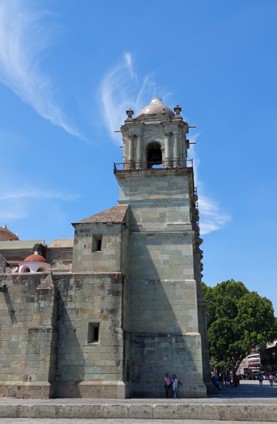Friday, June 16, 2023
By Jessica Hernández
The architectural legacy that the colonial era left in Mexico together with the traditions of the different states give a great identity to the entire Mexican territory. Oaxaca is precisely recognized for its buildings with unique facades, mixed between museums, churches, and old houses dating from the 1500s, together, these are part of a relic and architectural treasure that shows the ornamental richness of that time.
Not only in the city, which is considered a cultural heritage of humanity for all the tangible and intangible assets that it guards, there are also in other parts of the state buildings that are worth admiring for their colonial quarry design.
To talk about them we will start with the variety of religious temples:
In Oaxaca, as in most of the states of Mexico, there are numerous religious temples built during colonization, among them, we can find the temple of Santo Domingo and its ex-convent, the church of La Soledad, the temple of the Barrio de Jalatlaco, the church of San Felipe del Agua, Carmen Alto y Bajo, Church of the Ex Marquesado, and of course, the Cathedral located in the city’s main square, among many others. Most of these temples were built in the Baroque style, others in the Classical and Neoclassical styles. Currently, these temples are still in operation celebrating masses, their green and yellow quarry facades stand out with their internal decoration in the Baroque style.


In Oaxaca, as in most of the states of Mexico, there are numerous religious temples built during colonization, among them, we can find the temple of Santo Domingo and its ex-convent, the church of La Soledad, the temple of the Barrio de Jalatlaco, the church of San Felipe del Agua, Carmen Alto y Bajo, Church of the Ex Marquesado, and of course, the Cathedral located in the city’s main square, among many others. Most of these temples were built in the Baroque style, others in the Classical and Neoclassical styles. Currently, these temples are still in operation celebrating masses, their green and yellow quarry facades stand out with their internal decoration in the Baroque style.

Among other buildings of this style are the arches of the Xochimilco neighborhood, nestled in a narrow cobbled street, these functioned as an aqueduct that supplied water to the city. The Plaza de la Constitución, or as we mostly know it, the zócalo, in its colonial times only consisted of a marble fountain, which was replaced years later by the kiosk and has been modified over the years. The government palace is located in this same square, which held its first council session in 1576.

The city of Oaxaca and the state, in general, is home to many buildings that have their origins in colonial times, although some do not retain their original construction due to the earthquakes that have struck Oaxaca in different years, they have been rebuilt, seeking in each remodeling the take care of his style so that the state preserves its viceregal essence.
